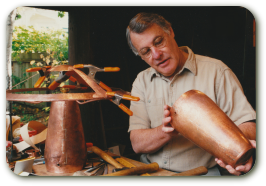Product Description
 ompare or top line copper roof finials and copper roof turret products to any other finial and turret manufacturer and you will quickly appreciate our product’s uniqueness, quality, All copper construction construction and overall value. These are hand crafted, made in the USA, custom made to order copper roof finial and copper roof turret products.
ompare or top line copper roof finials and copper roof turret products to any other finial and turret manufacturer and you will quickly appreciate our product’s uniqueness, quality, All copper construction construction and overall value. These are hand crafted, made in the USA, custom made to order copper roof finial and copper roof turret products.
- Our copper roof finials are made with 16 oz. US copper.
- All of our copper roof finials are handcrafted to order and to fit your exact needs.
- Copper will last a lifetime and does not rot like wood, rust like steel, or crack like clay.
- Copper roof finials will add curb appeal, value and be an elegant finishing touch to your home or other building.
- Our copper roof finials come with a 'perfect fit' guarantee to snugly fit the specified pitch of your roof.
Finial Finish:
All copper construction, polished that will patina over time.
Finial Dimensions:
48 in. double ball turret finial 8 in. seamless ball & 3 in. ball
ABOUT THE ART OF 'COPPERSMITH'

A coppersmith, also known as a "brazier", is a person who makes artifacts from copper and brass. Brass is an alloy of copper and zinc.The term redsmith is used for a tinsmith that uses tinsmithing tools and techniques to make copper items.
History of the Coppersmith
Anthropologists believe copper to be the first metal used by humans due to its softness and ease to manipulate. In antiquity, copper's durability and resistance to rust or corrosion proved valuable. Copper's relationship with man is thought to date back over six thousand years. Copper was particularly worked in England, with ores smelted in Wales as early as the 1500s. Copper was found in great quantities in North America, especially Montana, as well as archaic copper mines near Lake Superior, which was recording by a Jesuit missionary in 1659.
Coppersmithing as a trade benefited strongly from the invention of sheet metal rollers. Copper sheet was then available in a much more versatile and easy form for creating copper wares. By the 1700s, coppersmiths lived in the American colonies, but did not have access to much sheet copper due to the Crown's regulation of copper and other goods to the Americas. Sheet metal production was prohibited in the colonies as well before the American Revolution.
Coppersmith Trade
Most coppersmiths can create, from a pattern, copper wares from a sheet of copper. Our coppersmiths use this approach to create our standard line of roof vents. However, completely custom creations are always available, even if t s to be a standard roof vent in a very special size. Our coppersmiths specialize in specific forms or items such as roof vents and chimney caps.
In the 1700 and 1800's, coppersmiths typically had a few apprentices in various stages of learning the trade working together. Apprentices would start learning the trade usually around 8 or 9 years old. Typical duties of a youth in the copper shop would include tasks such as breaking coke or sal ammoniac blocks, scouring copper pieces to prepare them for tinning, and polishing hammers and tools.









